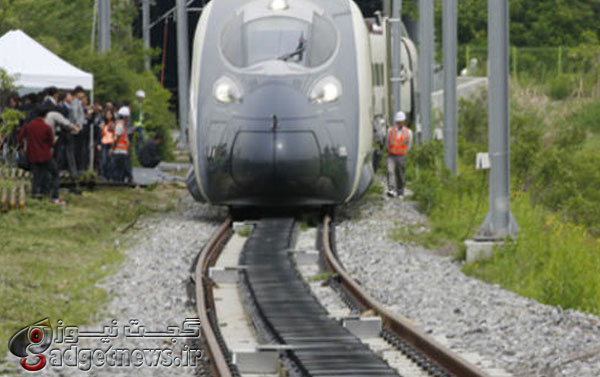
استفاده از تکنولوژي وايرلس در همه موارد کاربرد دارد و اين بار ، قطاری که توسط کرهایها نخستین تست خود را پشت سر گذاشته، میتواند بدون نیاز به شبکههای سیمی و با استفاده از انتقال نیروی برق وایرلسی حرکت کند. در ادامه با توضيحات تکميلي گجت نيوز را همراهي کنيد .
قطارهای پرسرعت برقی برای رسیدن به بالاترین سرعت مجبور به گرفتن مقدار بسیار زیادی انرژی از شبکه هستند که معمولا از طریق سیمهای برقی هوایی این اتفاق میافتد. اما قطار جدیدی که توسط کرهایها ساخته شده، میتواند از مسیر ریلی خود برق دریافت کند.این نمونه اولیه که با همکاری انستیتو پیشرفته علوم و فناوری و مرکز تحقیقات خطوط ریلی کره جنوبی ساخته شده، نخستین وسیله نقلیه ریلی است که به شکل بیسیم انرژی دریافت میکند.
شیوه کار این سیستم به این صورت است که یک برگرداننده نزدیک خط ریلی، الکتریسیتهای معادل 1 مگاوات را به سیمپیچهای (Coil) منتقلکننده برق که در میانه مسیر ریلی هستند میفرستد. این نیروی برق باعث تولید یک میدان مغناطیسی با فرکانس بالای 60 کیلوهرتز میشود. با پخششدن میدان مغناطیسی یک ردیف از سیمپیچهای جمعآوریکننده انرژی در قطار این میدان مغناطیسی را جذب و فورا تبدیل به یک جریان برق 1.2 مگاواتی میکنند.این جریان برق 1.2 مگاواتی توسط چهار سیمپیچ جمعآوریکننده 300 کیلوواتی که هر کدام در زیر واگنهای قطار هستند، جذب میشود.
چنین سیستمی همین حالا هم در کره و در اتوبوسهای حمل مسافر استفاده میشود؛ سیستمی که نقل و انتقال مسافران را بدون نیاز به ایستگاه شارژ فراهم میکند.البته این طرح در حالت مقدماتی قرار دارد و در نخستین تست که دو روز پیش انجام شد، این قطار تنها توانست به حداکثر سرعت 4 کیلومتر بر ساعت برسد و مسیری 150 متری را بپیماید. اگر همهچیز بهخوبی پیش برود، این قطار بهزودی به سرعت 400 کیلومتر بر ساعت خواهد رسید.محققین این پروژه معتقدند که این طرح میتواند با حذف شبکههای سیمی تا نیمی از هزینهها را برای تولید خطوط ریلی برقی کاهش دهد.
منبع : gizmodo
To get up to top speed, bullet trains have to pull a huge amount of electrical current from the grid. typically through unsightly overhead power lines. But this newly debuted train prototype from South Korea sucks up electricity invisibly from the tracks below.
Developed through a collaboration of the Korea Advanced Institute of Science and Technology and The Korea Railroad Research Institute, this bullet train is the first rail vehicle utilize wireless power transmission. According to the Korea JoonAng Daily, the system works as such:
A power inverter located near the railway sends electricity of about one megawatt through power-transfer coils installed in the middle of track. The electricity forms a high frequency magnetic field of about 60 kilohertz, by switching the polarization from plus to minus 60,000 times per second. As the magnetic field spreads, a line of current collector coils in the train above the power-transfer coil in the track absorbs the magnetic field and immediately transfers it into about 1.2 megawatts of electricity.
That 1.2 MW is absorbed by one of four 300 KW collector coils situated on the underside of each train car. It’s essentially the same type of wireless technology that has driven electric buses in the region for the past few years and has been proposed stateside for propelling electric passenger cars without the need for charging stations.
“The institute aims to start commercializing the wireless power technology on light rails in next five years,” Lee Jun-ho, a senior researcher at the institute, told JoongAng. “We will keep researching to advance the technology to make it applicable to subways and bullet trains like KTX.”
And though it only topped out at a pokey 4 km/h (that’s about 2.5 mph, slower than most folks walk) along a 492-foot long track in Uiwang, Gyeonggi last Tuesday, the prototype train could one day hit speeds of 400 km/h (250 mph). Researchers also estimate that such a system could reduce maintenance costs by more than half by eliminating the tangled web of existing overhead power lines. Looks like cord cutting is no longer limited to the realm of American cable television. [The Korea Railroad Research Institute via JoongAng Daily]
 گجت نیوز آخرین اخبار تکنولوژی، علم و خودرو
گجت نیوز آخرین اخبار تکنولوژی، علم و خودرو 





